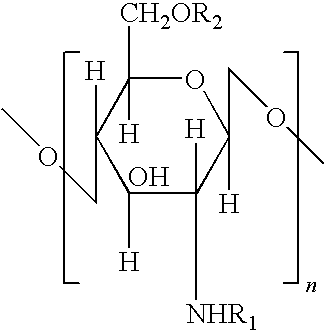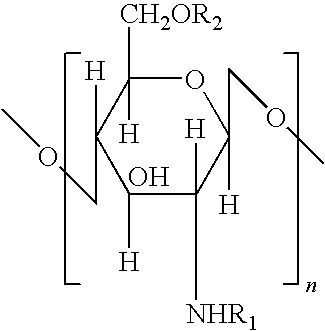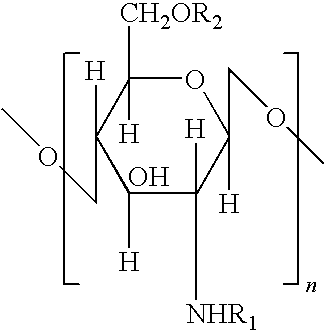Chitosan-based fiber material, its preparation method and use
a technology of chitosan-based fibers and fibers, applied in the field of medical materials, can solve the problems of not always effective hemorrhage control, weak hydrophilicity, and relatively poor hemostatic effect of massive hemorrhage, and is exposed to a risk of spreading animal viral diseases
- Summary
- Abstract
- Description
- Claims
- Application Information
AI Technical Summary
Benefits of technology
Problems solved by technology
Method used
Image
Examples
example 1
Preparation of a Water-Soluble Carboxymethyl Chitosan Fiber Non-Woven Fabric
[0040]12 g of chitosan fiber non-woven fabric having an average weight of 20.5 mg / cm2 is weighed into a 500 ml wide-necked flask, and 200 g of 45% aqueous KOH solution is added with stirring, so that chitosan fiber non-woven fabric is fully immersed into the alkaline solution. The flask with the content therein is placed at a temperature of −20° C. for 24 hours and the content is alkalized. The resulting alkalized chitosan fiber non-woven fabric is transferred into a 500 ml wide-necked flask, and 180 g of 55% aqueous acetone solution is added as a reaction medium, and 85 g of 50% monochloroacetic acid solution in ethanol is added as a reaction reagent with agitating. After reaction for 9 hours at room temperature, carboxymethyl chitosan potassium fiber non-woven fabric is obtained. The carboxymethyl chitosan potassium fiber non-woven fabric is washed sufficiently with 60% aqueous acetone solution till neutra...
example 2
Preparation of a Water-Soluble Carboxymethyl Chitosan Fiber
[0041]5 g of chitosan fiber having a length of 10 cm is weighed into a 500 ml wide-necked flask, and 160 g of 30% aqueous NaOH solution is added with stirring, so that chitosan fiber is fully immersed into the alkaline solution. The flask with the content therein is placed at room temperature for 48 hours and the content is alkalized. The resulting alkalized chitosan fiber is transferred into a 500 ml wide-necked flask, and 160 g of methanol is added as a reaction medium, and 46 g of 50% monochloroacetic acid solution in methanol is added as a reaction reagent with agitating. After reaction for 8 hours at room temperature, carboxymethyl chitosan sodium fiber is obtained. The carboxymethyl chitosan sodium fiber is washed sufficiently with methanol till neutral, then subjected to pressing or centrifugal drying to remove excess liquid, and dried in a vacuum drier containing P2O5. Then residual organic solvent is removed from th...
example 3
Preparation of a Water-Soluble Carboxymethyl Chitosan Fiber Knitted Fabric
[0043]10 g of chitosan fiber knitted fabric having an average weight of 15.6 mg / cm2 is weighed into a 500 ml wide-necked flask, and 200 g of 40% aqueous NaOH solution is added with stirring, so that chitosan fiber knitted fabric is fully immersed into the alkaline solution. The flask with the content therein is placed at a temperature of 0-4° C. for 48 hours and the content is alkalized. The resulting alkalized chitosan fiber knitted fabric is transferred into a 500 ml wide-necked flask, and 135 g of 90% aqueous ethanol solution and 50 g of dimethyl sulfoxide are added as reaction medium, and 70 g of 50% monochloroacetic acid solution in ethanol is added as a reaction reagent with agitating. After reaction for 10 hours at room temperature, carboxymethyl chitosan sodium fiber knitted fabric is obtained. The carboxymethyl chitosan sodium fiber knitted fabric is washed sufficiently with 75% aqueous ethanol soluti...
PUM
| Property | Measurement | Unit |
|---|---|---|
| temperature | aaaaa | aaaaa |
| temperature | aaaaa | aaaaa |
| temperature | aaaaa | aaaaa |
Abstract
Description
Claims
Application Information
 Login to View More
Login to View More - R&D
- Intellectual Property
- Life Sciences
- Materials
- Tech Scout
- Unparalleled Data Quality
- Higher Quality Content
- 60% Fewer Hallucinations
Browse by: Latest US Patents, China's latest patents, Technical Efficacy Thesaurus, Application Domain, Technology Topic, Popular Technical Reports.
© 2025 PatSnap. All rights reserved.Legal|Privacy policy|Modern Slavery Act Transparency Statement|Sitemap|About US| Contact US: help@patsnap.com



